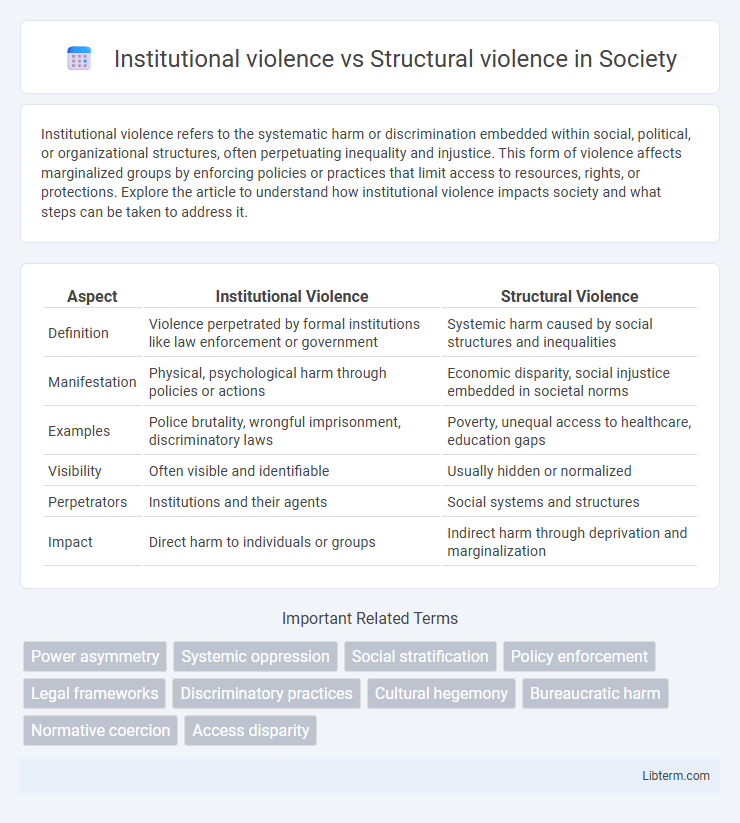Institutional violence refers to the systematic harm or discrimination embedded within social, political, or organizational structures, often perpetuating inequality and injustice. This form of violence affects marginalized groups by enforcing policies or practices that limit access to resources, rights, or protections. Explore the article to understand how institutional violence impacts society and what steps can be taken to address it.
Table of Comparison
| Aspect | Institutional Violence | Structural Violence |
|---|---|---|
| Definition | Violence perpetrated by formal institutions like law enforcement or government | Systemic harm caused by social structures and inequalities |
| Manifestation | Physical, psychological harm through policies or actions | Economic disparity, social injustice embedded in societal norms |
| Examples | Police brutality, wrongful imprisonment, discriminatory laws | Poverty, unequal access to healthcare, education gaps |
| Visibility | Often visible and identifiable | Usually hidden or normalized |
| Perpetrators | Institutions and their agents | Social systems and structures |
| Impact | Direct harm to individuals or groups | Indirect harm through deprivation and marginalization |
Defining Institutional Violence
Institutional violence refers to harm or injustice perpetuated through the policies, practices, and procedures of formal organizations or institutions, such as governments, schools, or healthcare systems. It manifests when these entities systematically discriminate, oppress, or marginalize individuals or groups, often maintaining unequal power dynamics. Unlike individual acts of violence, institutional violence is embedded in organizational frameworks and is sustained by established protocols and norms.
Understanding Structural Violence
Structural violence refers to systematic inequality embedded within social, economic, and political institutions that restricts individuals' access to resources and opportunities, causing harm without direct physical force. Unlike institutional violence, which involves explicit actions by organizations or authorities, structural violence is more insidious, manifesting through policies, cultural norms, and economic disparities that perpetuate poverty, discrimination, and social injustice. Understanding structural violence requires analyzing power dynamics and social structures that invisibly shape and constrain marginalized communities' lives, often resulting in chronic health disparities and reduced life expectancy.
Key Differences Between Institutional and Structural Violence
Institutional violence refers to harm caused by policies, practices, and actions within organizations or institutions, often manifesting through discriminatory laws, enforcement, and administrative procedures. Structural violence denotes the systemic inequities embedded in social, economic, and political systems that disadvantage particular groups, resulting in unequal access to resources, rights, and opportunities. The key difference lies in institutional violence being perpetrated by identifiable entities or organizations, while structural violence is dispersed throughout societal frameworks and norms perpetuating inequality.
Historical Origins of Both Forms
Institutional violence originates from policies and practices within established organizations such as governments, corporations, and the military, often rooted in historical frameworks of power and control shaped by colonialism and authoritarian regimes. Structural violence stems from systemic inequalities embedded in social, economic, and political institutions, with origins traced back to unequal distributions of wealth and access established during industrialization and the expansion of capitalist economies. Both forms of violence perpetuate long-standing cycles of marginalization and oppression through entrenched institutional mechanisms and social hierarchies.
Examples of Institutional Violence in Society
Institutional violence manifests through policies and practices within organizations that systematically disadvantage certain groups, such as racial profiling by law enforcement or discriminatory practices in education and employment. Examples include police brutality targeting minority communities, unequal access to healthcare resulting from systemic biases, and biased judicial sentencing that disproportionately affects marginalized populations. These acts reveal how institutional frameworks perpetuate harm by embedding inequity into societal functions.
Manifestations of Structural Violence in Daily Life
Structural violence manifests in daily life through systemic inequalities such as limited access to quality education, healthcare disparities, and economic marginalization that disproportionately affect marginalized communities. These institutionalized inequities are embedded within social, political, and economic frameworks, leading to chronic poverty, unemployment, and inadequate housing. The persistent nature of structural violence fosters social exclusion and undermines individuals' well-being without direct physical harm.
Intersections and Overlaps: Where the Two Meet
Institutional violence manifests through policies and practices within organizations that systematically oppress marginalized groups, while structural violence refers to the broader social and economic systems that perpetuate inequality and limit access to resources. The intersections between institutional and structural violence occur when discriminatory institutional actions reinforce and are reinforced by societal structures, creating overlapping layers of harm that entrench social injustices. Understanding these overlaps highlights how systemic racism, economic deprivation, and political disenfranchisement collectively sustain cycles of violence across multiple dimensions of society.
Impact on Marginalized Communities
Institutional violence manifests through policies and practices in organizations that disproportionately harm marginalized communities, reinforcing inequality and limiting access to resources like education, healthcare, and justice. Structural violence underpins these inequities by embedding social, economic, and political disparities within society's framework, perpetuating poverty, discrimination, and exclusion. Both forms of violence synergistically exacerbate systemic barriers, deepening social injustice and impairing the well-being and agency of vulnerable populations.
Addressing and Reducing Violence: Policy and Reform
Policy and reform efforts targeting institutional violence prioritize accountability measures, transparent oversight, and enforcing anti-discrimination laws within organizations like law enforcement and hospitals. Structural violence reduction requires systemic approaches addressing socioeconomic inequalities, education access, and healthcare disparities through comprehensive legislation and community investment programs. Effective violence prevention integrates data-driven strategies, multi-sector collaboration, and continuous monitoring to transform both institutional practices and entrenched social structures.
Moving Toward Social Justice and Equity
Institutional violence manifests through policies and practices within organizations that perpetuate inequality, while structural violence refers to systemic social arrangements that harm marginalized groups by restricting their access to resources and rights. Moving toward social justice and equity requires dismantling these interconnected forms of violence by implementing inclusive policies, promoting equitable resource distribution, and amplifying marginalized voices to reshape power dynamics. Effective strategies include reforming institutions to prioritize human rights and embedding equity-focused frameworks that address root causes of systemic oppression.
Institutional violence Infographic

 libterm.com
libterm.com